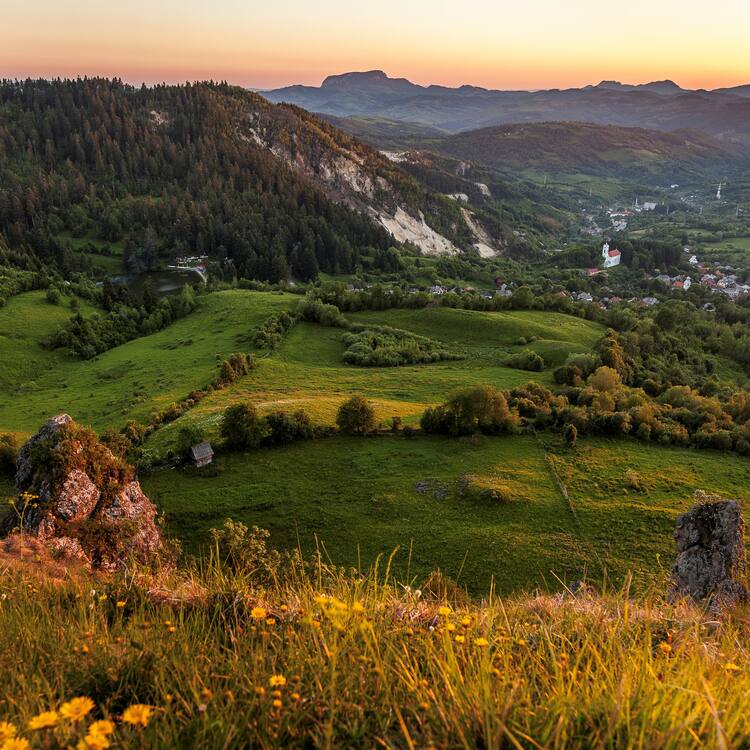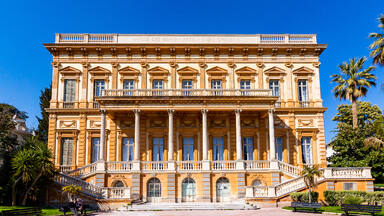Roșia Montană Mining Landscape
Roșia Montană Mining Landscape
Description is available under license CC-BY-SA IGO 3.0
Paysage minier de Roșia Montană
Description is available under license CC-BY-SA IGO 3.0
مشهد المناجم في روشيا مونتانا
يقع موقع روشيا مونتانا ضمن جبال "أبوسيني" في سلسلة جبال "ميتاليفيري" في غرب رومانيا، ويمثِّل هذا الموقع، حتى تاريخ إدراجه في القائمة، أهم مجمَّع معروف في رومانيا لاستخراج الذهب من باطن الأرض، والأوسع نطاقاً والأكثر تنوعاً من الناحية التقنية. وقد عرف هذا الموقع في عهد الإمبراطورية الرومانية باسم "ألبورنوس مايور"، وكان منجماً كبيراً لاستخراج الذهب، فقد استخرج الرومان خلال 166 عاماً، اعتباراً من عام 106 ميلادي، زهاء 500 طن من الذهب من هذا الموقع، حيث عملوا على تطوير وسائل تقنية رفيعة المستوى، كحفر عدة أنواع من الممرات التي يصل طولها مجتمعة إلى 7 كيلومترات، وإنشاء عدد من النواعير، وذلك في أربعة مواقع تحت الأرض كانت قد اختيرت للكثافة المرتفعة للخامات فيها. وقد قدَّمت ألواح كتابة خشبية مطلية بالشمع معلومات مفصلة قانونية واجتماعية واقتصادية وسكانية ولغوية عن أنشطة التعدين الرومانية، وهي لا تخصُّ موقع "ألبورنوس مايور" بمفرده، وإنما تتعلق أيضاً بكل إقليم داشه. ويبيِّن هذا الموقع الدمج بين تكنولجيا التعدين الرومانية المستوردة والتقنيات التي طُورت محلياً والتي كانت مجهولة في أماكن أخرى خلال هذه الحقبة المبكرة. واستمر نشاط التعدين في الموقع بين العصور الوسطى والعصر الحديث، ولكنه كان أضعف من قبل. وقد قامت أنشطة التعدين الأخيرة حول الممرات الرومانية أو ضمنها، ويأتي هذا الموقع ضمن مشهد زراعي رعوي يبيِّن إلى حدٍّ كبير بنية المجتمعات المحلية التي دعمت أنشطة التعدين بين القرن الثامن عشر والقرن العشرين.
source: UNESCO/CPE
Description is available under license CC-BY-SA IGO 3.0
罗西亚蒙大拿矿业景观
source: UNESCO/CPE
Description is available under license CC-BY-SA IGO 3.0
Горнопромышленный ландшафт Рошия-Монтанэ
source: UNESCO/CPE
Description is available under license CC-BY-SA IGO 3.0
Paisaje minero de Roșia Montană
source: UNESCO/CPE
Description is available under license CC-BY-SA IGO 3.0
Outstanding Universal Value
Brief synthesis
Roșia Montană Mining Landscape contains the most significant, extensive and technically diverse underground Roman gold mining complex currently known in the world, dating from the Roman occupation of Dacia (106-271 CE). Roșia Montană is situated in a natural amphitheatre of massifs and radiating valleys in the Metalliferous range of the Apuseni Mountains, located in the historical region of Transylvania in the central part of Romania.
Roman gold mining occurred within four small mountains (Cârnic, Lety, Orlea and Cetate) that visually dominate the landscape of Roșia Montană, itself surrounded on three sides by dividing ridges and peaks. Roman archaeology in the surrounding landscape is prolific and pervasive, comprising ore-processing areas, living quarters, administrative buildings, sacred areas and necropoli, some with funerary buildings with complex architecture, all set in relation to over 7 km of ancient underground workings that have been discovered to date.
Criterion (ii): Roșia Montană Mining Landscape contains the world’s pre-eminent example of underground Roman gold mining and demonstrates an interchange of values through innovative techniques developed by skilled migrant Illyrian-Dalmatian miners to exploit gold in ways that suited the technical nature of the deposit. Multiple chambers that housed treadmill-operated water-dipping wheels for drainage represent a technique likely routed from Hispania to the Balkans, whilst perfectly carved trapezoidal-section galleries, helicoidal shafts, inclined communication galleries with stairways cut into the bedrock, and vertical extraction areas (stopes) superimposed above one another with the roof carved out in steps, are in a combination so specific to Roșia Montană that they likely represent pioneering aspects in the technical history of mining.
Criterion (iii): Roșia Montană Mining Landscape embodies the cultural traditions of one of the oldest documented mining communities in Europe, anciently founded by the Romans, as manifested in extant underground mining works, chronologically differentiated by distinctive technical features; and a socio‐technical mining landscape consisting of ore‐processing areas, habitation areas, sacred places and necropoli. The interpretation of its history is enriched by Roman wax‐coated wooden writing tablets discovered in the mines during the 18th and 19th centuries. Together with prolific stone epigraphic monuments, they provide an authentic picture of daily life and cultural practice in this ancient frontier mining community.
Combined with outcomes of recent, intensive and systematic archaeological investigation, an exceptional reflection of Roman mining practices has emerged.
Criterion (iv): Roșia Montană Mining Landscape illustrates the strategic control and vigorous development of precious metals’ mining by the Roman Empire, essential for its longevity and military power. Following the decline of mining in Hispania, Roșia Montană located in Aurariae Dacicae (Roman Dacia) was the only significant new source of gold and silver for the Roman Empire, among the likely key motivations for Trajan’s conquest.
Integrity
Roșia Montană contains all the elements necessary to express the values of the property for the Roman mining period. The property is of adequate size to ensure the complete representation of the features and processes which convey its significance. Moreover, the property comprises an area in which future archaeological research will probably discover a large number of further surface and underground mining, ore processing and settlement sites of the Roman period. However, the current mining proposal means that the integrity of the property is highly vulnerable.
Authenticity
The property contains attributes that are high in authenticity in terms of the location and the form and materials of surviving historic features, with a clear sense of how, when and by whom mining shaped the land. In terms of knowledge, epigraphic and documentary evidence combined with a decade of intensive systematic archaeological investigation has provided a major contribution to the understanding of Roman mining techniques and organisation. There is considerable potential for future research and for new discoveries related to many periods of the region’s mining history. However, the current mining proposal means that the authenticity of the property is highly vulnerable.
Protection and management requirements
Roșia Montană Mining Landscape is legally protected in accordance with Romanian law as a World Heritage property.
The protection of Roșia Montană is supported by listing under the Law for the protection of historic monuments (L. 422/2001) which allows for the development of urban planning measures. Currently there are no planning controls in place and these need to be urgently developed. Currently there are active mining licences on the property and inadequate controls to stop these being extended. To activate these, permits need to be approved. There is clearly a need for the development of a General Urban Plan (Plan Urbanistic General) and a Zonal Urban Plan (Plan Urbanistic Zonal) to restrict approvals for mining permits.
The management plan for the property is being finalized by the National Institute of Heritage who is also responsible for the monitoring of the property. The management plan should be augmented by an internationally supported conservation plan and a tourism strategy should be implemented.


